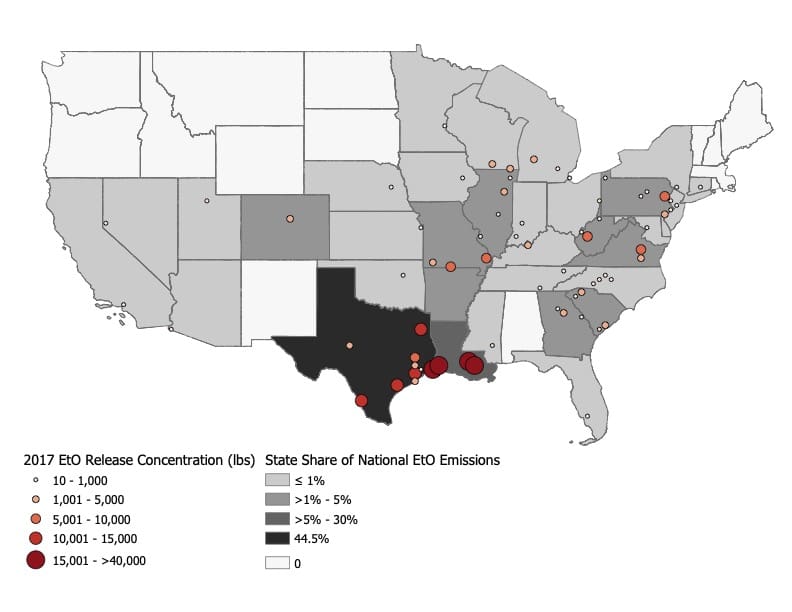Tell the EPA to address cancer risks in ALL Houston-area communities
In May of this year, the Environmental Protection Agency’s (EPA) Region 6 office held a Webinar to provide a general overview of Ethylene Oxide (EtO) pollution and its potential health effects. This webinar was a prelude to EPA Region 6’s efforts to speak to communities that are disproportionately burdened by EtO pollution risks. We encouraged you to participate in the webinar to better understand the chemical, its sources, and the risks associated with it, because this knowledge is crucial to the effort to push EtO pollution out of communities. A recording of this overview webinar is available from the EPA’s website for you to review.
As the EPA moves forward in its efforts to reach out to specific communities impacted by EtO emissions, we at Air Alliance Houston are concerned about the EPA’s choice to only share information regarding the Shell Technology Center in Houston’s Westside as a representative of the Houston area while there are many more EtO polluting facilities with far greater impacts to public health in East Harris County. EPA’s own modeling suggests that these individual facilities each emit many times more EtO than the Shell Technology Center and that the cumulative impact from the East Harris County facilities are responsible for some of the highest cancer-risk rates in the state.
The EPA is holding a second virtual public meeting on EtO for the Houston area on August 26. Please join us to raise concerns over the focus of EPA’s community outreach and their hesitance to study the full extent of how EtO is impacting the region. The EPA-designated meeting format permits comments from just two preselected community representatives. However, anyone can ask questions during the Q&A section.
When: Thursday, August 26, 2021 at 6pm
Where: Online – Click here for information on joining the webinar.
What is Ethylene Oxide (EtO)? Why does it matter?
Ethylene oxide is a colorless, flammable gas used to sterilize medical equipment and make a range of products, including plastics and other products. Breathing air contaminated with this chemical can increase your risk of breast cancer and various lymphoid cancers. In their most recent published study from 2016, the EPA concluded that EtO is in fact 30 times more carcinogenic than they had previously thought. Texas accounts for nearly half the entire country’s EtO output, with at least 27 facilities emitting more than 48 tons of the health-harming chemical every year.
Why was the Shell Technology Center in Westside chosen as a representative for the Houston area?
The short answer is that a 2020 report issued by the EPA’s Office of Inspector General (OIG) calling for increased public risk communication identified the Shell Technology Center as a top EtO emitter in the region and apparently overlooked other facilities in the area. The EPA Region 6 community outreach effort was then designed to focus on the deficiencies outlined in the OIG letter. However, this facility is clearly a lower priority emitter than other Houston-area facilities and we are unsure why the OIG overlooked more dangerous facilities and why EPA Region 6 has decided to perpetuate this oversight in its public risk communication endeavor. This is what we want to know.
The EPA standard for significant risk is a modeled excess cancer risk of 100 in a million persons. The stated cancer risk (2018) for some of the communities surrounding the Shell Technology Center is 40 in a million for EtO. While this is not an insignificant number, we would like to point out the East Harris County facilities (below) where cancer risks are much higher and community notification should be a priority. Again, the EPA is not directly notifying residents impacted by these facilities despite the significantly elevated cancer risk.
Which facilities should have been monitored?
Cancer risk values per million:
- LyondellBasell Bayport
- Surrounding cancer risk (2014): 100 in a million
- Celanese Ltd
- Surrounding cancer risk (2014): 90 in a million
- Clariant Corp Clear Lake
- Surrounding cancer risk (2014): 90 in a million
- Lyondell Chemical Co. Channelview
- Surrounding cancer risk (2014): 100 in a million
Furthermore, the modeled cancer risk in certain areas directly downwind of these facilities ranges from 119 to over 300 in a million – cancer risks that EPA’s models directly attribute to EtO emissions.
As seen in the EPA data provided above, communities within the east side of Houston host numerous facilities emitting even more significant quantities of ethylene oxide into the air than the Shell Technology Center. In addition, some of these facilities have documented histories of high-priority violations of Clean Air Act standards according to EPA ECHO compliance data. Yet the focus of community outreach efforts continues to ignore these facilities.
It is apparent that the EPA – including the Office of the Inspector General and Region 6 – fundamentally misprioritized its approach in selecting the Shell Technology Center as the sole representative Houston-area EtO emitting facility to dedicate its risk assessment and outreach efforts. In doing so the agency has chosen to overlook both the historic and ongoing ethylene oxide burden placed on east Houston communities.
Moving forward, the agency should not only include these communities in their outreach efforts but should also center them in upcoming initiatives to reduce EtO emissions in the area and region.

Top 25 Ethylene Oxide (EtO) Emission Sources (2018)
How to join the upcoming meeting.
When: Thursday, August 26, 2021, at 6pm
Meeting Link: https://usepa.zoomgov.com/j/1619056932 (Meeting ID: 161 905 6932)
Dial-in Audio ONLY for Meeting (Note: Translation and toll-free are not available for dial-in): +1 669 254 5252; +1 646 828 7666; +1 551 285 1373; or +1 669 216 1590 (Meeting ID: 161 905 6932)
American Sign Language services will be available during the meeting via the above URL link
Click here for information on joining the webinar.
I’d like to ask a question but don’t know how to phrase it. – Some helpful resources
- From the One Breath Partnership: What is Ethylene Oxide?
- From the Environmental Protection Agency: Hazardous Air Pollutants: Ethylene Oxide
- From the One Breath Partnership: How TCEQ made a cancer-causing chemical seem safer than it is
- AAH Press Release: Organizations pressure EPA, TCEQ, and other Region 6 state agencies to inform communities about increased risk of cancer from ethylene oxide
- From the One Breath Partnership: Environmental agencies aren’t protecting Texans from a cancer-causing chemical
- From The Intercept: TRACKING THE INVISIBLE KILLER: Trump EPA Invited Companies to Revise Pollution Records of a Potent Carcinogen
- From The Intercept: THE WAR ON THE WAR ON CANCER: Trump’s Gutting of Toxics Regulations Will Mean Higher Profits for Polluters and Higher Cancer Rates for the American People

